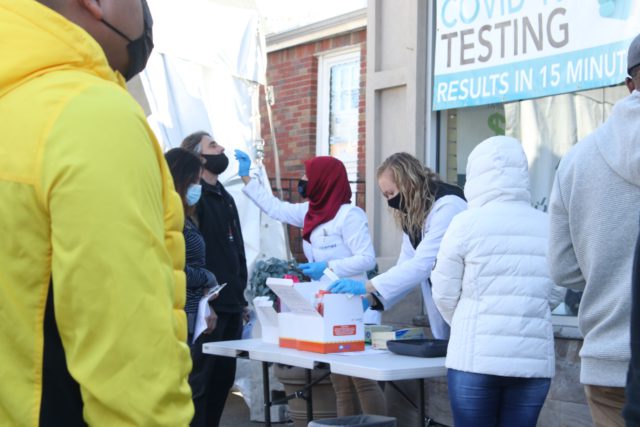At the time of writing, California’s LA County alone has reached a staggering 8000 hospitalized cases of COVID-19—with 20% of these patients requiring Intensive Care. Almost one-year into the global pandemic, California’s State Legislation has updated Assembly Bill 685 to take effect January 1, 2021 requiring that:
1. Employers notify all employees at a worksite of potential exposures, COVID-19-related benefits and protections, and disinfection and safety measures; and,
2. Employers notify local public health agencies of all workplace outbreaks.
Assembly Bill 685 further authorizes the California Division of Occupational Safety and Health to issue an Order Prohibiting Use to shut down an entire worksite or a specific worksite area that exposes employees to COVID-19. 
With this, how can your organization prepare for a COVID-19 outbreak and how can you ensure your emergency management team has the resources needed to stay compliant?
Let’s look at how Assembly Bill 685 could affect all California-based organizations and what solutions you can take today to support ongoing public health measures and minimize further business disruptions from COVID-19.
California Assembly Bill 685 – Emergency Management Measures Effective January 1 2021
1. What changes have been made to Assembly Bill 685 COVID-19 Infection Prevention Requirements?
Assembly Bill 685 furthers California’s Division of Occupational Safety and Health ability to enforce COVID-19 infection prevention requirements. By allowing Orders Prohibiting Use and citations for serious COVID-19 related violations to be issued more quickly, Assembly Bill 685 requires employers to notify all organizational members to potential COVID-19 exposures and notify local public health agencies of workplace outbreaks.
2. What is considered a COVID-19 workplace outbreak?
The California Department of Public Health defines an outbreak in non-healthcare or non-residential workplace settings as three or more confirmed cases of COVID-19 among employees who live in different households within a two-week period.
3. What must employers notify workers of?
 Employers are required to notify all employees and subcontracted employees of potential exposure to COVID-19 and provide them with certain information regarding COVID-19-related benefits and options. Employers must also communicate disinfection and safety plans that they will undertake per the guidelines of the Centers for Disease Control and Prevention.
Employers are required to notify all employees and subcontracted employees of potential exposure to COVID-19 and provide them with certain information regarding COVID-19-related benefits and options. Employers must also communicate disinfection and safety plans that they will undertake per the guidelines of the Centers for Disease Control and Prevention.
4. Who must employers notify?
Assembly Bill 685 requires that employers must provide written notice to all employees who were at the same worksite as the person with a confirmed COVID-19 infection or who was subject to a COVID-19-related quarantine order. Written notice must be delivered to all employees within one business day after becoming aware of the infection and potential exposure.
Further, employers must notify local public health agencies of outbreaks within 48 hours of becoming aware of the number of cases that meets the definition of an outbreak. Local public health agencies require the following from employers required to make outbreak notification reports:
1. Name, phone number, occupation, and worksite of employees who may have COVID-19 or who are under a COVID-19 isolation order; and,
2. The business address and NAICS industry code of the worksite where the infected or quarantined individuals work.
An employer that has an outbreak must continue to notify the local health department of any subsequent confirmed cases of COVID-19 at the worksite.
What Does This Mean For You?
Organizations with operations and employees in California must be prepared and equipped with the resources needed to notify employees and local health authorities about confirmed COVID-19 preventative measures and confirmed cases.
A lack of preparation or inability to meet workplace requirements or notification reporting periods puts every organization at risk of serious COVID-19 violations that could lead to an immediate workplace shutdown.
To minimize the risk of COVID-19 outbreaks, ongoing business disruptions, and subsequent reputational impacts, there are several strategies that can help your organization stay compliant and keep your people and workplaces safe.
5 Considerations for Managing COVID-19 Under AB 685
Risk Management, Work Health and Safety, and Emergency Management teams should be equipped with the resources and digital tools necessary to meet public health regulations; and a critical event management and communications platform, such as CQ, can provide tremendous benefit. To best prepare for and respond to a potential COVID-19 outbreak, the following five strategies and capabilities should be considered when designing an action plan to respond to COVID-19:
1. Centralized COVID-19 Intelligence: Centrally tracking and recording each workplace infection in a virtual critical event room will enable your team to establish a single operating picture of a rapidly changing environment. Further, by centralizing COVID-19 data your organization can create a single source of truth to assist your team in determining if your confirmed workplace cases of COVID-19 meet the definition of an “outbreak”.
With limited access and controlled user permissions, this private event room can ensure that your employee’s sensitive personal information remains safe while meeting the data reporting needs of public health authorities. 
2. Clear Messaging Aligned with CDC Advice: Having clearly articulated COVID-19 notification templates drafted in line with CDC guidelines and ready to be delivered is key to meeting time sensitive requirements.
Where appropriate, response teams can consider publishing a dedicated web page with the most up-to-date organizational advice for both their employees and community stakeholders to access from home.
3. Rapid Communications: The ability to communicate with workers and sub-contractors via SMS and email is critical to delivering COVID-19 notifications.
Knowing that some workers may not check their email outside of normal working hours (or when on holiday leave), relying on email alone as a means of notifying employees about COVID-19 outbreaks could be insufficient. To send mass notifications in real-time that are more likely to reach all employees during a critical event, SMS functions will rapidly increase your ability to provide crucial information and guidance.
4. Triaging Exposure with Rapid Two-way Engagement: Another benefit to enabling SMS functions is the immediate ability to triage remote employees’ health and wellbeing. Concerned about site-based employees having been exposed to a confirmed case of COVID-19? Two-way messaging allows emergency management teams to poll all employees about their location and potential symptoms.
5. Governance Reporting: It’s vitally important to be able to produce reports outlining timestamped evidence of actions taken against the timeline of events.
Good governance reporting can demonstrate to authorities that a prudent and compliant response to a potential COVID-19 outbreak was taken thereby reducing the risk of shutdown and subsequent disruption. To enable event tracking and support incident reporting to local public health authorities, critical event management platforms like CQ can be relied on for speed and ease.
—
Digital Emergency Management Solutions
Virtual emergency management platforms that enable mass communications bring simplicity to managing both health emergencies and subsequent compliance. By offloading the task of manually tracking workplace employees, recordkeeping, time stamps, and ingoing and outgoing communications, an automated communication and notification system can confidentially store needed data, send out organization wide alerts, and generate instant reports that meet compliance needs.
Preparing your organization to meet legislative requirements is just one of the major benefits to adopting a virtual critical event management system.
Beyond supporting public health measures to slow down the pace of the ongoing COVID-19 pandemic, proactively equipping your emergency management team with the resources needed to track, isolate, and notify your community about potential COVID-19 outbreaks can keep your workplace and people safe.
If you’re interested in a turnkey solution to a mass communications and emergency notification system to support your team during this unfolding event, please reach out to the Catalyst Technologies team today.
—
Sources
- Cal/OSHA: COVID-19 Infection Prevention Requirements
- New Zealand Herald, California Sees Two-day Record of COVID-19 Deaths
- California Legislative Information 2021
- California Department of Industrial Relations 2021














